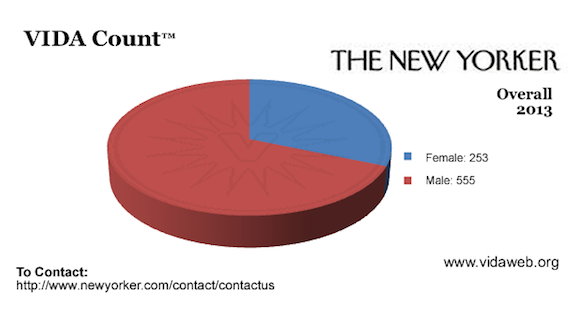Anyone familiar with bestselling novelist Jennifer Weiner’s multi-pronged campaign against sexism in the book world knows that literary chauvinism is alive and well.
The fifth annual VIDA Count, a “tally [of] the gender disparity in major literary publications and book reviews,” suggests that Weiner’s message is getting through. The author’s longtime target, The New York Times Book Review, reached near parity last year with a 55% male and 45% female spread among its reviewers. Slate credits that progress to new efforts to correct gender imbalances at the Times:
Last year, incoming editor Pamela Paul pledged to feature “a diversity of author backgrounds and ideologies and arguments, a diversity of genre, a diversity of subject matter” in the review…. It did that by publishing more books by female authors than its peers do, but it also did it by focusing on hiring female critics to review them — one aspect of the process that can’t be explained away by the habits of publishing houses.
VIDA’s Amy King notes that The Paris Review, “previously among the worst in our VIDA Count, ha[s] metamorphosed from deep, male-dominated lopsidedness into a picture more closely resembling gender parity. While such progress is remarkable in one year, we are likewise pleased to note that we haven’t heard anyone bemoan a drop in quality in The Paris Review’s pages. Turnarounds like the Paris Review’s make it clear that with the right editorial effort, putting more sustainable gender practices into action isn’t too difficult for these magazines at the top of the major market heap.”
Smaller literary publications deserving of praise for equal treatment and coverage include Tin House, Poetry, Boston Review, Ninth Letter, and Conjunctions.
As for the “75%ers” whose attachment to male privilege is as pathological as the Oscars’, here’s the (largely liberal) list of shame: The Atlantic, London Review of Books, New Republic, The Nation, New York Review of Books, and New Yorker.
For more stats and charts, visit the VIDA Count site.






